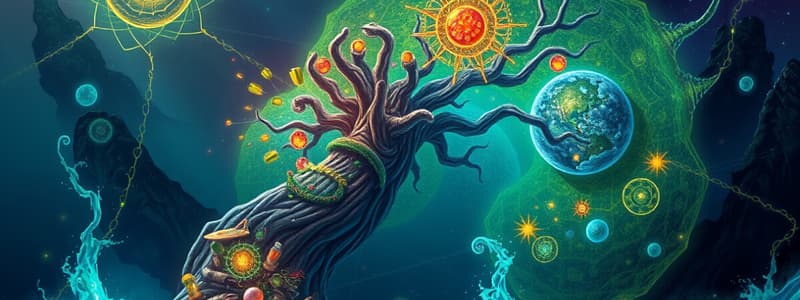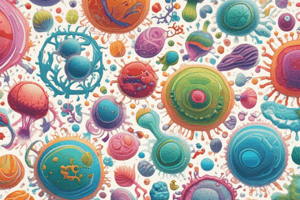Podcast
Questions and Answers
What is essential for living organisms to maintain a stable internal environment?
What is essential for living organisms to maintain a stable internal environment?
- Homeostasis (correct)
- Adaptation
- Genetic variation
- Reproduction
What is a primary role of genes in living organisms?
What is a primary role of genes in living organisms?
- Enhancing biodiversity
- Facilitating reproduction
- Determining characteristics (correct)
- Regulating temperature
Which of the following best describes an adaptation?
Which of the following best describes an adaptation?
- A permanent alteration to enhance survival (correct)
- A genetic mutation that is random
- An inherited trait that has no effect on survival
- A temporary change in behavior
How do organisms respond to environmental changes?
How do organisms respond to environmental changes?
What does biodiversity encompass?
What does biodiversity encompass?
Which statement about evolution is accurate?
Which statement about evolution is accurate?
How do penguins exemplify the idea of adaptations?
How do penguins exemplify the idea of adaptations?
Why is reproduction crucial for living organisms?
Why is reproduction crucial for living organisms?
Which of the following domains includes prokaryotic organisms?
Which of the following domains includes prokaryotic organisms?
What is the correct order of classification from least inclusive to most inclusive?
What is the correct order of classification from least inclusive to most inclusive?
Which kingdom does corn belong to?
Which kingdom does corn belong to?
Which category above species includes more types of organisms?
Which category above species includes more types of organisms?
What is the primary focus of systematics in biology?
What is the primary focus of systematics in biology?
Which of the following correctly identifies the supergroup of humans?
Which of the following correctly identifies the supergroup of humans?
In the taxonomy hierarchy, which category comes directly above 'family'?
In the taxonomy hierarchy, which category comes directly above 'family'?
Which of the following categories represents the least inclusive classification?
Which of the following categories represents the least inclusive classification?
Which of the following does not describe a characteristic common to all living organisms?
Which of the following does not describe a characteristic common to all living organisms?
What level of organization includes both living organisms and their physical environment?
What level of organization includes both living organisms and their physical environment?
What is the term for the process that transmits genetic information from one generation to the next?
What is the term for the process that transmits genetic information from one generation to the next?
Which classification rank is considered the least inclusive?
Which classification rank is considered the least inclusive?
What is identified as the primary mechanism driving evolution?
What is identified as the primary mechanism driving evolution?
Which of the following groups includes organisms without a true nucleus?
Which of the following groups includes organisms without a true nucleus?
Which of the following incorrectly pairs a scientific concept with its description?
Which of the following incorrectly pairs a scientific concept with its description?
What term is used to describe the permanent loss of a species from the planet?
What term is used to describe the permanent loss of a species from the planet?
Which domain contains unicellular prokaryotes that can adapt to extreme environments?
Which domain contains unicellular prokaryotes that can adapt to extreme environments?
What is the primary characteristic that differentiates eukaryotes from prokaryotes?
What is the primary characteristic that differentiates eukaryotes from prokaryotes?
Which of the following statements about Domain Bacteria is true?
Which of the following statements about Domain Bacteria is true?
What is a requirement when specifying an organism's name?
What is a requirement when specifying an organism's name?
Which of the following domains includes both unicellular and multicellular organisms?
Which of the following domains includes both unicellular and multicellular organisms?
Escherichia coli is an example of which type of organism?
Escherichia coli is an example of which type of organism?
What type of environment are organisms in Domain Archaea most typically found?
What type of environment are organisms in Domain Archaea most typically found?
Which statement differentiates prokaryotes from eukaryotes?
Which statement differentiates prokaryotes from eukaryotes?
What does the horizontal axis in the graph represent?
What does the horizontal axis in the graph represent?
What is the cholesterol level at week 2 according to the data?
What is the cholesterol level at week 2 according to the data?
Which type of publication typically contains articles written by reporters for a broader audience?
Which type of publication typically contains articles written by reporters for a broader audience?
What does the vertical bar in the graph represent?
What does the vertical bar in the graph represent?
What is the blood cholesterol level at week 4?
What is the blood cholesterol level at week 4?
Flashcards are hidden until you start studying
Study Notes
Domains of Life
- Supergroups are exclusive to the Domain Eukarya.
- Proper organism identification requires the full binomial name, e.g., Homo sapiens.
Domain Archaea
- Composed of unicellular prokaryotes found in extreme environments similar to primitive Earth.
- Prokaryotic cells lack a membrane-bound nucleus.
- Organisms adapt to harsh conditions and can absorb or chemosynthesize food.
Domain Bacteria
- Contains unicellular prokaryotes that inhabit diverse environments, including on human skin and in the gut.
- Prokaryotic cells exhibit various shapes.
- Organisms can absorb, photosynthesize, or chemosynthesize food.
Homeostasis in Organisms
- Essential for living organisms to maintain constant internal conditions despite environmental changes.
- Includes the monitoring of temperature, moisture level, pH, etc., within tolerable ranges.
- Body systems employ feedback and control mechanisms to achieve homeostasis.
Reproduction and Development
- All organisms must reproduce to sustain populations; methods vary by species.
- Genetic information is passed to the next generation through genes, which are composed of DNA.
- Genes determine organism traits.
Adaptations and Evolution
- Adaptations are modifications that enhance survival in specific environments.
- Biodiversity arises from organisms evolving new adaptations over time in response to environmental changes.
- Evolution involves population changes that improve suitability for their environment, driven by natural selection.
Biodiversity
- Defined by the number of species, genetic variation, and ecosystem diversity.
- Biodiversity is crucial for ecological balance and resilience.
Taxonomy and Classification
- Taxonomy identifies, names, and classifies organisms systematically based on evolutionary relationships.
- Hierarchical classification categories include: species, genus, family, order, class, phylum, kingdom, supergroup, and domain, from least to most inclusive.
Levels of Classification Examples
- Human:
- Domain: Eukarya
- Supergroup: Opisthokonta
- Kingdom: Animalia
- Corn:
- Domain: Eukarya
- Supergroup: Archaeplastids
- Kingdom: Plantae
Properties of Living Organisms
- Organisms exhibit various properties, including reproduction, response to environmental changes, and the ability to care for offspring.
- Ecosystems encompass multiple interactions between organisms and their environments.
Evolutionary Theory
- Natural selection is the mechanism of evolution, leading to the adaptation and development of species over time.
- Extinction represents the permanent loss of a species, linked to various environmental and anthropogenic factors.
Studying That Suits You
Use AI to generate personalized quizzes and flashcards to suit your learning preferences.



